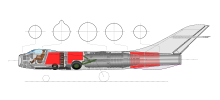The Sukhoi Su-17 (Aircraft R) was a prototype Soviet fighter. The name was later reused for an entirely different fighter-bomber, see Sukhoi Su-17.
YouTube Encyclopedic
-
1/3Views:1 286197 895941
-
Footage of Su-22s of MFG-28 (East German navy) at laage, September 1990.
-
First Russian (Soviet) jets MiG 15, 17,19, 21 Sukhoi 7, 9, 11 Wings of Russia documentary
-
Modernisation of the Chinese People's Liberation Army Air Force - Part 1 (1949-1989) [Widescreen]
Transcription
Development
The Su-17 was designed to closely match the theoretical TsAGI calculations for supersonic performance. The aircraft had a 50° swept wing fitted with air brakes and boosted controls. A unique feature was that in addition to an ejection seat, the entire nose section of the aircraft could separate from the rest of the airframe.[1] The project was canceled with no flights due to problems with wing structure, ongoing difficulties with the development of the TR-3 engine, and the closure of the Sukhoi OKB. The only example was eventually used as a gunfire target.[2]
Specifications (Su-17 interceptor)

Data from OKB Sukhoi[3]
General characteristics
- Crew: 1
- Length: 15.253 m (50 ft 1 in)
- Wingspan: 9.6 m (31 ft 6 in)
- Height: 4.52 m (14 ft 10 in)
- Wing area: 27.5 m2 (296 sq ft)
- Airfoil: root:TsAGI 9030, tip:SR-3-12
- Empty weight: 5,932 kg (13,078 lb)
- Research variant: 6,240 kg (13,760 lb)
- Gross weight: 7,890 kg (17,394 lb)
- Research variant: 7,390 kg (16,290 lb)
- Fuel capacity: 1,219 L (322 US gal; 268 imp gal)
- Powerplant: 1 × Lyulka TR-3 turbojet, 45.11 kN (10,141 lbf) thrust
Performance
- Maximum speed: 1,209 km/h (751 mph, 653 kn) at sea level
- Research variant: 1,252 km/h (676 kn; 778 mph)
- Landing speed: 188 km/h (102 kn; 117 mph)
- Research variant: 194 km/h (105 kn; 121 mph)
- Maximum speed: Mach 0.985
- Range: 855 km (531 mi, 462 nmi) at 830 km/h (450 kn; 520 mph) at 10,000 m (33,000 ft)
- Endurance: 52 minutes
- Service ceiling: 14,500 m (47,600 ft)
- Research variant: 15,500 m (50,900 ft)
- Time to altitude: 4 minutes to 10,000 m (33,000 ft) (Research variant 3.5 minutes)
- Wing loading: 287 kg/m2 (59 lb/sq ft)
Armament
2x 37 mm (1.457 in) Nudelman N-37 cannon with 40 rpg
References
- ^ Shavrov V.B. (1994). Istoriia konstruktskii samoletov v SSSR, 1938-1950 gg. (3 izd.) (in Russian). Mashinostroenie. ISBN 5217004770.
- ^ Gunston, Bill (1995–2000). The Osprey Encyclopedia of Russian Aircraft (2 ed.). Osprey. ISBN 1-84176096-X.
- ^ Antonov, Vladimir; Gordon, Yefim; others (1996). OKB Sukhoi. Leicester: Midland. ISBN 978-1-85780-012-8.

